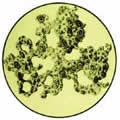|
The Origin of Life
 DIVIDING CELLS
DIVIDING CELLS
The most fundamental rule of life is the
principle that "life comes only from life."
A life form can originate only from another
life form. |
Evolutionists hold that living things
spontaneously formed themselves from inanimate
matter. However, this is a medieval superstition
contradicting the main laws of biology.
For many people, the question of
"whether men descended from apes or not"
springs to mind when Darwin's theory is mentioned.
Before coming to that, however, there are numerous
questions the evolutionary theory needs to answer.
The first question is how the first living organism
appeared on earth.

Evolutionists answer this question
by saying that the first organism was a cell that
emerged from inanimate matter by chance. According
to the theory, at a time when the earth consisted
of inanimate rocks, soil, gases and so on, a living
organism formed by chance through the effects
of wind, rain, and lightning. This evolutionary
claim, however, is contrary to one of the most
fundamental rules of biology: Life comes only
from life, which means that inanimate matter cannot
generate life.
The belief that inanimate matter
can produce life is actually a medieval superstition.
According to this theory, called "spontaneous
generation", it was believed that mice sprang
naturally from wheat, or maggots arose "spontaneously"
from meat. At the time when Darwin put forward
his theory, the belief that microbes of their
own accord formed themselves from inanimate matter
was also very common.
| |
"MUD THAT COMES TO
LIFE"
The scientific name of the picture on the
side is "Bathybius Haeckelii", that is,
"Haeckel Mud". Ernst Haeckel, an ardent
proponent of the theory of evolution, came
to observe the mud dredged up by an exploratory
vessel and thought that it closely resembled
some cells he had seen under a microscope.
Thus, he claimed that it is an inanimate
material that turns into a living organism.
Haeckel and his associate Darwin believed
that life was simple enough to be formed
out of inanimate material. 20th century
science demonstrated, however, that life
can never arise from lifelessness.
|
 |
The findings of the French biologist
Louis Pasteur put an end to this belief. As he
put it: "The claim that inanimate matter
can originate life is buried in history for good."2
| |

|
|
SPONTANEOUS
GENERATION: A MEDIEVAL SUPERSTITION
One of the superstitious beliefs held by
medieval people was that inanimate matter
could spontaneously give rise to life. It
was believed, for instance, that frogs and
fish formed spontaneously from mud lying
in riverbeds. It was later revealed that
this hypothesis, known as "spontaneous generation",
was simply a fallacy. However, though somewhat
later and with a slightly different scenario,
this belief was revived under the name of
"the theory of evolution". |
After Pasteur, evolutionists
still maintained that the first living cell formed
by chance. However, all experiments and research
carried out throughout the 20th century ended
in failure. The "chance" formation of
a living cell aside, it has not even been possible
to produce a living cell by a conscious process
in the most advanced laboratories of the world.
|  THE
MYTH OF "CHEMICAL EVOLUTION" THE
MYTH OF "CHEMICAL EVOLUTION"
Renowned evolutionist Alexander Oparin
came up with the idea of "chemical evolution"
at the beginning of the 20th century. This
idea holds that the first living cell emerged
by chance through some chemical reactions
that took place in primordial earth conditions.
However, no evolutionist, including Oparin,
was able to submit any evidence to support
the "chemical evolution" allegation. On
the contrary, every new discovery in the
20th century showed that life was too complex
to have originated by chance. Well-known
evolutionist Leslie Orgel makes this admission:
"(Examining the structures of DNA, RNA and
proteins), one might have to conclude that
life could never, in fact, have originated
by chemical means."4
|
Therefore, the question of how the
first living organism emerged puts the evolutionary
claim into a quandary right at the first step.
One of the chief defenders of the theory of evolution
at the molecular level, Prof. Jeffrey Bada, makes
this confession:
Today as we leave the twentieth century,
we still face the biggest unsolved problem that
we had when we entered the twentieth century:
How did life originate on Earth?3
While invalidating the
theory of evolution, the law "life comes
from life" also shows that the first life
on earth came again from life, which means that
it was created by God. He is the only One Who
can give life to inanimate matter. In the words
of the Qur'an, "It is He Who brings out the
living from the dead, and brings out the dead
from the living." (Surat ar-Rum: 19) |
